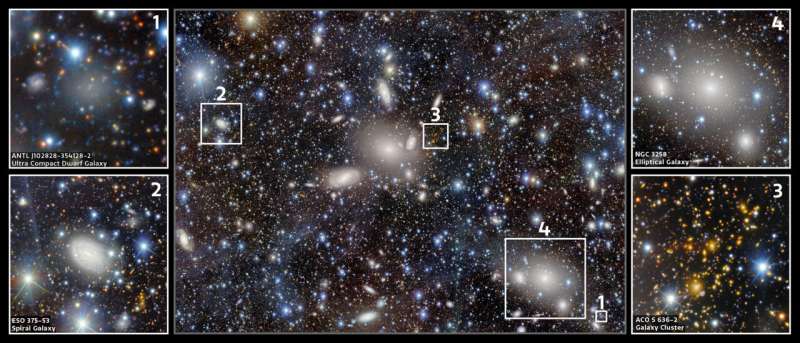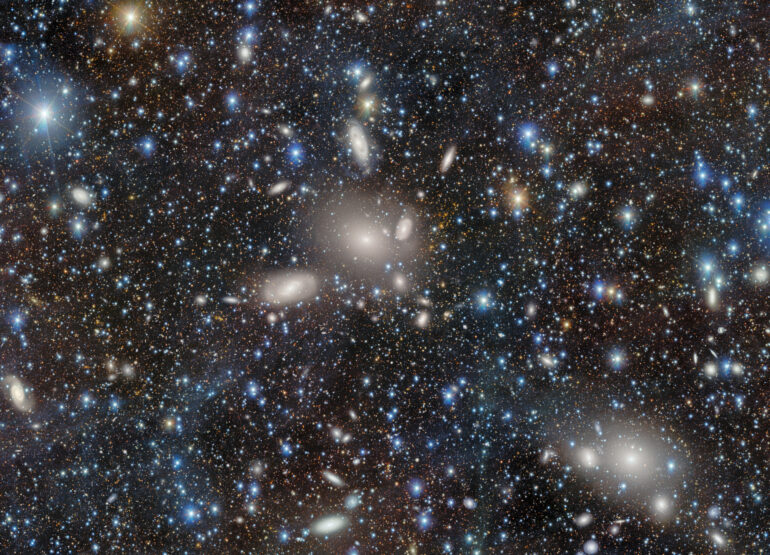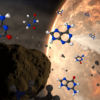NSF NOIRLab rings in the New Year with a glittering galaxyscape captured with the Department of Energy-fabricated Dark Energy Camera, mounted on the U.S. National Science Foundation Víctor M. Blanco 4-meter Telescope at Cerro Tololo Inter-American Observatory in Chile, a Program of NSF NOIRLab. This ultra-deep view of the Antlia Cluster reveals a spectacular array of galaxy types among the hundreds that make up its population.
Galaxy clusters are some of the largest known structures in the known universe. Current models suggest that these massive structures form as clumps of dark matter and the galaxies that form within them are pulled together by gravity to form groups of dozens of galaxies, which in turn merge to form clusters of hundreds, even thousands.
One such group is the Antlia Cluster (Abell S636), located around 130 million light-years from Earth in the direction of the constellation Antlia (the Air Pump).

This excerpt shows a small selection of the myriad picturesque galaxies that can be found within the Antlia Cluster — a group of at least 230 galaxies located about 130 million light-years away. This image was taken with the 570-megapixel Department of Energy-fabricated Dark Energy Camera (DECam), mounted on the U.S. National Science Foundation (NSF) Víctor M. Blanco 4-meter Telescope at Cerro Tololo Inter-American Observatory in Chile, a Program of NSF NOIRLab. It captures only a portion of the 230 galaxies that so far have been found to make up the Antlia Cluster. DECam’s ultra-deep view showcases the variety of galaxies within and beyond the cluster in incredible detail. © Dark Energy Survey/DOE/FNAL/DECam/CTIO/NOIRLab/NSF/AURA. Image processing: R. Colombari & M. Zamani (NSF NOIRLab)
Several programs of NOIRLab have contributed to observations of the Antlia Cluster over the past 20 years. Scientists from Chile have used both the Blanco telescope (with its predecessor camera MOSAIC II) and the Gemini South telescope, one half of the International Gemini Observatory, operated by NSF NOIRLab, to examine the cluster through the Antlia Cluster Project.
In more recent years, researchers have investigated the cluster from space- and ground-based observatories. These combined efforts have revealed a dynamic menagerie of rarer galaxy types within the cluster.
The Antlia Cluster is dominated by two massive elliptical galaxies—NGC 3268 and NGC 3258. These central galaxies are surrounded by a number of faint dwarf galaxies. Researchers believe these two galaxies are in the process of merging, based on X-ray observations that revealed a ‘rope’ of globular clusters along the peak area of light between them. This may be evidence that the Antlia cluster is really two smaller clusters that are combining.
The cluster is rich in lenticular galaxies—a type of disk galaxy that has little interstellar matter and thus little ongoing star formation—and also hosts some irregular galaxies. A plethora of rarer, low-luminosity dwarf galaxies have been found in the cluster, including ultra-compact dwarfs, compact ellipticals, and blue compact dwarfs. The cluster may also contain dwarf spheroidal galaxies and the ultra-diffuse galaxy sub-type, though further investigations are needed to confirm them.
Many of these galaxy types have only been identified within the past few decades because of advances in observational equipment and data analysis techniques that can better capture the low luminosity and relatively smaller size of these galaxies.
Evaluating galaxy types allows astronomers to plot the fine details of galaxy evolution, and some galaxies rich with dark matter provide further opportunities for astronomers to understand this mysterious substance that makes up 25% of the universe.
The development of larger and more highly sensitized cameras like DECam allows astronomers to see the fainter details of these superstructures, such as the diffuse light between the cluster galaxies, which is a combination of intracluster light—the feeble glow of stars flung out into the gravitational field of the cluster by the churn of interacting galaxies—and faded light from the nearby Antlia Supernova Remnant discovered in 2002.
NSF–DOE Vera C. Rubin Observatory’s upcoming Legacy Survey of Space and Time will be the first astronomical survey to provide scientists with the data they need to detect intracluster light in thousands of galaxy clusters, unlocking clues to the distribution of dark matter around galaxy clusters and the evolutionary history of the universe on large scales.
Citation:
Dark energy camera captures the glittering galaxies of the Antlia Cluster (2025, January 1)



